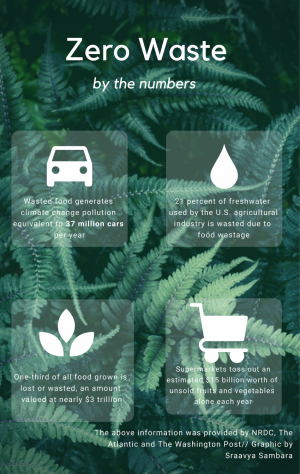The invisible crisis of vanishing fish
October 13, 2019
Pacific Catch. Bubba Gump Shrimp Co. Cioppino’s.
These restaurants, famous for their seafood and fish, may soon struggle to find any fish to serve at all with the plummeting fish stocks of today’s international fisheries. Commercial fish stocks are at risk of passing the point of no return in as little as 40 years, after which populations may be unable to recover forever.
World Wildlife Fund (WWF) spells the situation out: “two-thirds of the world’s fish stocks are either fished at their limit or over fished. The UN Food and Agriculture Organization (FAO) has estimated that 70 percent of the fish population is fully used, overused, or in crisis.”
The Guardian also has numerous articles published detailing the effects of overfishing, one of which reveals tuna species to be under severe duress. Bluefin tuna has already been labeled as critically endangered, “with just 2 percent of their 1950 biomass left.” And bigeye and yellowfin populations are not much better, according to journalist Jonathan Watts.
Nevertheless, bluefin are still caught en masse by multinational conglomerate Mitsubishi and served in restaurants around the globe, as are many other commercial fish species. As big companies continue to capitalize on diminishing fisheries at the risk of forfeiting fish entirely for future generations, local fishers pay the price.
“Fish ranks as one of the most highly traded food commodities and fuels a $362 billion global industry,” the WWF states. “Millions of people in largely developing, coastal communities depend on the fishing industry for their livelihood and half the world’s population relies on fish as a major source of protein.”
Until now, however, fishing industries have been able to maintain a somewhat precarious balance by respecting the maximum sustainable yield (MSY), or the amount of fish that can be safely harvested so that fish populations can rebound and remain stable, if just barely. Unfortunately, according to DV AP Environmental Science teacher Mrs. Annie Nguyen, that may not be enough.
“For a long time, a lot of countries have been fishing right at MSY, but as we’re seeing changes in climate, we’re seeing more severity of storms, [and] fishing at MSY becomes a lot riskier, because you’re not guaranteed that those populations are going to be able to bounce back afterwards,” Nguyen explains.
The problems don’t stop there. Not only is overfishing an issue, but the fishing techniques so commonly adopted by the commercialized fishing industry also demand attention.
“The way that you catch fish isn’t necessarily equal across the board, because you have practices that are very destructive to the environment, like dynamite fishing or trawling — which is basically where you just drag a giant rake on the floor of the ocean and just kind of scoop up whatever falls into it, versus, like, long-line fishing or purse seine fishing.” Nguyen says. She also brings up the issue of bycatch — the unintended capture or harm of protected sea creatures or other fish — which is estimated to compose a significant percent of total catches. Compounded with the effects of overfishing, this issue further contributes to the depletion of fish stocks over time and unbalances marine ecosystems.
Despite these numerous man-made crises afflicting the oceans, it is not too late to reverse the effects of exploitation on the ocean.
For instance, National Geographic reports that with stricter management of fisheries, improved enforcement of laws regarding catches and the increased implementation of aquaculture, there is still hope of mending the damage done by overfishing.
In particular, the establishment of fishing rights has been proven to help stabilize fish populations.
“Fishermen receive a secure share of the catch, and they agree to adhere to strict limits that allow fish populations to rebuild. This long-term ownership stake — in the form of a percentage of the fishery — is an asset that a fisherman can sell or grant to his children. And when the fishery grows, his stake increases, along with his profits,” the Environmental Defense Fund explains. “A kind of rights-based fishing called catch shares has already transformed fisheries in the United States. Overfishing has dropped 60 percent in federal waters since 2000, and better management is providing more stable fishing jobs and increased revenue.”
In addition, the implementation of initiatives such as the mapping of Marine Protected Areas and increased consumer vigilance can help to decrease overfishing. Greater media attention and awareness about such issues, such as harmful fishing techniques, can also make a difference.
Furthermore, DV students can help encourage more responsible, sustainable practices of harvesting seafood and better care for marine ecosystems by simply investing more time to understand the topic. One accessible way to grow awareness is by using the Monterey Bay Aquarium’s Seafood Watch app or pamphlet to ensure that the seafood being consumed is sustainably sourced.
“The other thing is just diversifying the diet that you have, because a lot of people will find one thing that they like and just keep eating that. If you’re able to have more variety, that helps to relieve pressure on any one certain part of the population. Especially if you can go to places like Safeway or Whole Foods and you talk to the person behind the counter, you know, finding out where was this fished, is it farmed or is it wild. Just educating yourself more so that you can start making better choices.” Nguyen says.
Pacific Catch. Bubba Gump Shrimp Co. Cioppino’s.
These restaurants, famous for their seafood and fish, may soon struggle to find any fish to serve at all with the plummeting fish stocks of today’s international fisheries. Commercial fish stocks are at risk of passing the point of no return in as little as forty years, after which populations may be unable to recover forever.
World Wildlife Fund (WWF) spells the situation out, “two-thirds of the world’s fish stocks are either fished at their limit or over fished. The UN Food and Agriculture Organization (FAO) has estimated that 70 percent of the fish population is fully used, overused, or in crisis.”
The Guardian also has numerous articles published detailing the effects of overfishing, one of which reveals tuna species to be under severe duress. Bluefin tuna has already been labelled as critically endangered, “with just 2 percent of their 1950 biomass left.” And bigeye and yellowfin populations are not much better, according to journalist Jonathan Watts.
Nevertheless, bluefin are still caught en masse by multinational conglomerate Mitsubishi and served in restaurants around the globe, as are many other commercial fish species. As big companies continue to capitalize on diminishing fisheries at the risk of forfeiting fish entirely for future generations, local fishers pay the price.
“Fish ranks as one of the most highly traded food commodities and fuels a $362 billion global industry,” the WWF states. “Millions of people in largely developing, coastal communities depend on the fishing industry for their livelihood and half the world’s population relies on fish as a major source of protein.”
Until now, however, fishing industries have been able to maintain a somewhat precarious balance by respecting the maximum sustainable yield (MSY), or the amount of fish that can be safely harvested so that fish populations can rebound and remain stable, if just barely. Unfortunately, according to DV AP Environmental Science teacher Ms. Annie Nguyen, that may not be enough.
“For a long time, a lot of countries have been fishing right at MSY, but as we’re seeing changes in climate, we’re seeing more severity of storms, [and] fishing at MSY becomes a lot riskier, because you’re not guaranteed that those populations are going to be able to bounce back afterwards,” explains Nguyen.
The problems don’t stop there. Not only is overfishing an issue, but the fishing techniques so commonly adopted by the commercialized fishing industry also demand attention.
“The way that you catch fish isn’t necessarily equal across the board, because you have practices that are very destructive to the environment, like dynamite fishing or trawling — which is basically where you just drag a giant rake on the floor of the ocean and just kind of scoop up whatever falls into it, versus, like, long-line fishing or purse seine fishing.” says Nguyen. She brings up the issue of bycatch — the unintended capture or harm of protected sea creatures or other fish — which is estimated to compose a significant percent of total catches. Compounded with the effects of overfishing, this issue further contributes to the depletion of fish stocks over time and unbalances marine ecosystems.
Despite these numerous man-made crises afflicting the oceans it is not too late to reverse the effects of exploitation on the ocean.
For instance, National Geographic reports that with stricter management of fisheries, improved enforcement of laws regarding catches and the increased implementation of aquaculture, there is still hope of mending the damage done by overfishing.
In particular, the establishment of fishing rights has been proven to help stabilize fish populations.
“Fishermen receive a secure share of the catch, and they agree to adhere to strict limits that allow fish populations to rebuild. This long-term ownership stake — in the form of a percentage of the fishery — is an asset that a fisherman can sell or grant to his children. And when the fishery grows, his stake increases, along with his profits,” the Environmental Defense Fund explains. “A kind of rights-based fishing called catch shares has already transformed fisheries in the United States. Overfishing has dropped 60 percent in federal waters since 2000; and better management is providing more stable fishing jobs and increased revenue.”
In addition, the implementation of initiatives such as the mapping of Marine Protected Areas and increased consumer vigilance can help to staunch overfishing. Greater media attention and awareness about such issues, such as harmful fishing techniques, can also make a difference.
Furthermore, even DV students can help to encourage more responsible, sustainable practices of harvesting seafood and better care for marine ecosystems by simply investing more interest in the topic. One accessible way to grow awareness is by using the Monterey Bay Aquarium’s Seafood Watch app or pamphlet to ensure your seafood is sustainably sourced.
“The other thing is just diversifying the diet that you have, because a lot of people will find one thing that they like and just like keep eating that. If you’re able to have more variety, that helps to relieve pressure on any one certain part of the population. Especially if you can go to places like Safeway or Wholefoods and you talk to the person behind the counter, you know, finding out where was this fished, is it farmed, or is it wild. Just educating yourself more so that you can start making better choices,” Nguyen says.




